The Intel Core i9-9990XE Review: All 14 Cores at 5.0 GHz
by Dr. Ian Cutress on October 28, 2019 10:00 AM ESTCPU Performance: System Tests
Our System Test section focuses significantly on real-world testing, user experience, with a slight nod to throughput. In this section we cover application loading time, image processing, simple scientific physics, emulation, neural simulation, optimized compute, and 3D model development, with a combination of readily available and custom software. For some of these tests, the bigger suites such as PCMark do cover them (we publish those values in our office section), although multiple perspectives is always beneficial. In all our tests we will explain in-depth what is being tested, and how we are testing.
All of our benchmark results can also be found in our benchmark engine, Bench.
Application Load: GIMP 2.10.4
One of the most important aspects about user experience and workflow is how fast does a system respond. A good test of this is to see how long it takes for an application to load. Most applications these days, when on an SSD, load fairly instantly, however some office tools require asset pre-loading before being available. Most operating systems employ caching as well, so when certain software is loaded repeatedly (web browser, office tools), then can be initialized much quicker.
In our last suite, we tested how long it took to load a large PDF in Adobe Acrobat. Unfortunately this test was a nightmare to program for, and didn’t transfer over to Win10 RS3 easily. In the meantime we discovered an application that can automate this test, and we put it up against GIMP, a popular free open-source online photo editing tool, and the major alternative to Adobe Photoshop. We set it to load a large 50MB design template, and perform the load 10 times with 10 seconds in-between each. Due to caching, the first 3-5 results are often slower than the rest, and time to cache can be inconsistent, we take the average of the last five results to show CPU processing on cached loading.
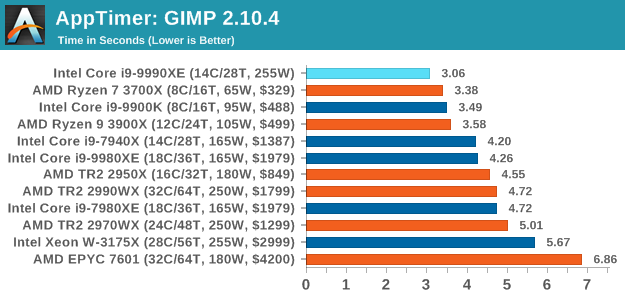
Application loading is a walk in the park for the Core i9-9990XE.
FCAT: Image Processing
The FCAT software was developed to help detect microstuttering, dropped frames, and run frames in graphics benchmarks when two accelerators were paired together to render a scene. Due to game engines and graphics drivers, not all GPU combinations performed ideally, which led to this software fixing colors to each rendered frame and dynamic raw recording of the data using a video capture device.
The FCAT software takes that recorded video, which in our case is 90 seconds of a 1440p run of Rise of the Tomb Raider, and processes that color data into frame time data so the system can plot an ‘observed’ frame rate, and correlate that to the power consumption of the accelerators. This test, by virtue of how quickly it was put together, is single threaded. We run the process and report the time to completion.

FCAT is getting fairly unified across all the processors, with only a few percent separating all the Intel parts.
3D Particle Movement v2.1: Brownian Motion
Our 3DPM test is a custom built benchmark designed to simulate six different particle movement algorithms of points in a 3D space. The algorithms were developed as part of my PhD., and while ultimately perform best on a GPU, provide a good idea on how instruction streams are interpreted by different microarchitectures.
A key part of the algorithms is the random number generation – we use relatively fast generation which ends up implementing dependency chains in the code. The upgrade over the naïve first version of this code solved for false sharing in the caches, a major bottleneck. We are also looking at AVX2 and AVX512 versions of this benchmark for future reviews.
For this test, we run a stock particle set over the six algorithms for 20 seconds apiece, with 10 second pauses, and report the total rate of particle movement, in millions of operations (movements) per second. We have a non-AVX version and an AVX version, with the latter implementing AVX512 and AVX2 where possible.
3DPM v2.1 can be downloaded from our server: 3DPMv2.1.rar (13.0 MB)
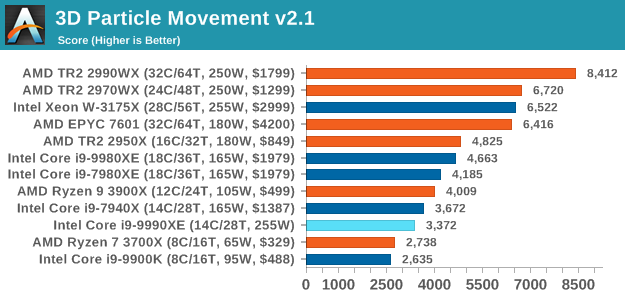
When we run our 3DPM test in a standard mode, the 9990XE again sees a slight regression compared to the 7940X, perhaps indicating that the mesh environment needs some extra MHz.
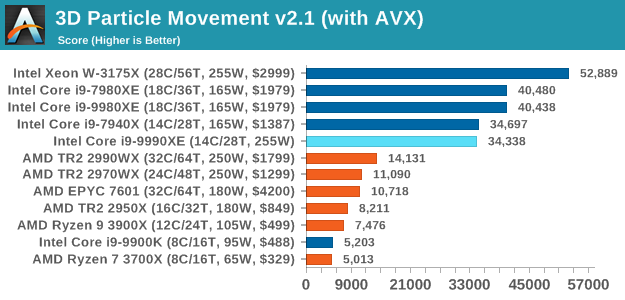
When adding AVX512 into the mix, the 9990XE rises up as with all the other Intel HEDT CPUs, but still can only match the slower 7940X despite having the same number of cores. At this point we're more core limited than frequency limited, indicating that there are some pipeline stalls in this test.
Dolphin 5.0: Console Emulation
One of the popular requested tests in our suite is to do with console emulation. Being able to pick up a game from an older system and run it as expected depends on the overhead of the emulator: it takes a significantly more powerful x86 system to be able to accurately emulate an older non-x86 console, especially if code for that console was made to abuse certain physical bugs in the hardware.
For our test, we use the popular Dolphin emulation software, and run a compute project through it to determine how close to a standard console system our processors can emulate. In this test, a Nintendo Wii would take around 1050 seconds.
The latest version of Dolphin can be downloaded from https://dolphin-emu.org/
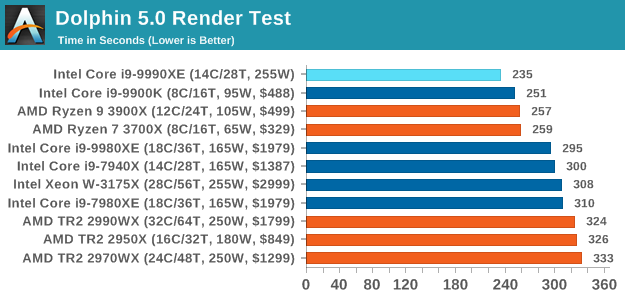
Dolphin is a heavily single threaded test, so we see the highest frequency from Intel and AMD at the top here.
DigiCortex 1.20: Sea Slug Brain Simulation
This benchmark was originally designed for simulation and visualization of neuron and synapse activity, as is commonly found in the brain. The software comes with a variety of benchmark modes, and we take the small benchmark which runs a 32k neuron / 1.8B synapse simulation, equivalent to a Sea Slug.

Example of a 2.1B neuron simulation
We report the results as the ability to simulate the data as a fraction of real-time, so anything above a ‘one’ is suitable for real-time work. Out of the two modes, a ‘non-firing’ mode which is DRAM heavy and a ‘firing’ mode which has CPU work, we choose the latter. Despite this, the benchmark is still affected by DRAM speed a fair amount.
DigiCortex can be downloaded from http://www.digicortex.net/
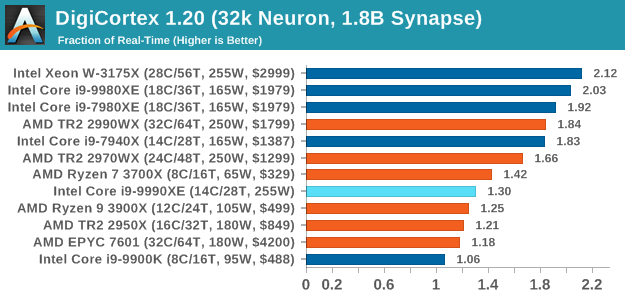
DigiCortex likes memory frequency and internal speeds more than raw core frequency, and again the 9990XE doesn't perform too well here.
y-Cruncher v0.7.6: Microarchitecture Optimized Compute
I’ve known about y-Cruncher for a while, as a tool to help compute various mathematical constants, but it wasn’t until I began talking with its developer, Alex Yee, a researcher from NWU and now software optimization developer, that I realized that he has optimized the software like crazy to get the best performance. Naturally, any simulation that can take 20+ days can benefit from a 1% performance increase! Alex started y-cruncher as a high-school project, but it is now at a state where Alex is keeping it up to date to take advantage of the latest instruction sets before they are even made available in hardware.
For our test we run y-cruncher v0.7.6 through all the different optimized variants of the binary, single threaded and multi-threaded, including the AVX-512 optimized binaries. The test is to calculate 250m digits of Pi, and we use the single threaded and multi-threaded versions of this test.
Users can download y-cruncher from Alex’s website: http://www.numberworld.org/y-cruncher/
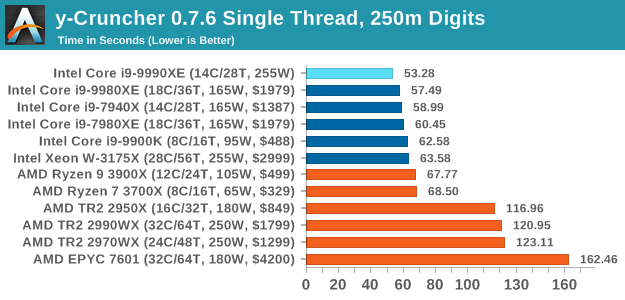
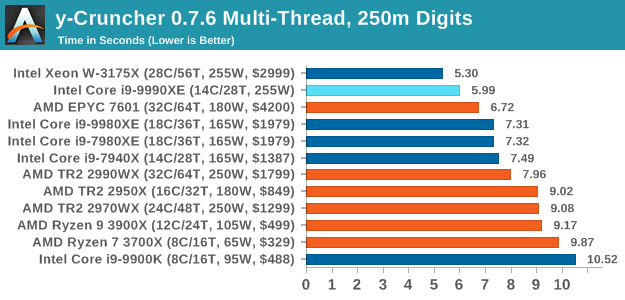
y-Cruncher is an AVX-512 accelerated test, and with the high frequency it gets the top score in our ST test.
Agisoft Photoscan 1.3.3: 2D Image to 3D Model Conversion
One of the ISVs that we have worked with for a number of years is Agisoft, who develop software called PhotoScan that transforms a number of 2D images into a 3D model. This is an important tool in model development and archiving, and relies on a number of single threaded and multi-threaded algorithms to go from one side of the computation to the other.
In our test, we take v1.3.3 of the software with a good sized data set of 84 x 18 megapixel photos and push it through a reasonably fast variant of the algorithms, but is still more stringent than our 2017 test. We report the total time to complete the process.
Agisoft’s Photoscan website can be found here: http://www.agisoft.com/
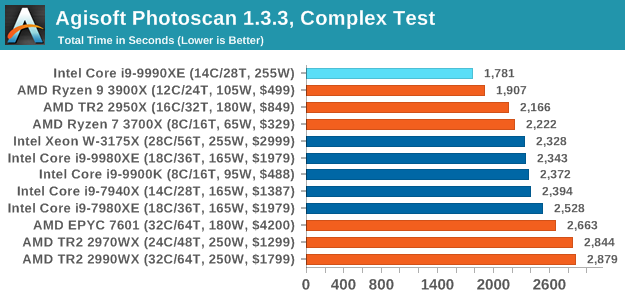
Agisoft is a variable threaded workload, and it seems the Core i9-9990XE has the best combination of cores and threads.












145 Comments
View All Comments
Batmeat - Monday, October 28, 2019 - link
Agreed.This chip is auction only. Expect to pay HUGE DOLLARS for this assuming you even have access to the auctions.
mrvco - Monday, October 28, 2019 - link
But the chip isn't selling for all that much at auction apparently... I was expecting much more than 2849 euros if this thing really is the golden ticket for HFT. From a financial perspective, this isn't worth Intel's time or effort relative to letting top-tier partners and resellers buy up the whole supply of 9990XE's to do the binning on their own. Regardless, it's less expensive than a Super Bowl ad I suppose and probably more effective considering their target audience.Cygni - Monday, October 28, 2019 - link
It is a niche product for a niche market... one that the article talked about at length. "Bragging rights" doesn't come into play when it is a tool for making money.willis936 - Monday, October 28, 2019 - link
It just doesn't make sense. If single threaded performance is king then why do you need 14 cores running at 5 GHz? If multithreaded performance is king then why not go wider? The low latency case doesn't make sense. You could assemble multiple systems focused on single threaded performance for less money than this 14 core auction-only chip costs. When people say it's only for bragging rights, they are not wrong.edzieba - Monday, October 28, 2019 - link
To GREATLY oversimplify HFT loads:you want as many cores as you can get, but those cores must respond as quickly as possible. You're effectively packet-watching: as soon as you see a packet you need to read it, determine if it is to be acted upon, determine how it is to be acted upon, and then respond, and you need to do it faster than everyone else. Everyone else has as close as is possible to the same network latency (e.g. stock exchanges employ huge fibre loops to ensure every endpoint has the same light-speed lag), so if you can run at 5GHz vs. 4GHz of your competitors you can respond to any given packet before they can. It's only a hair faster, but if you're jsut barely first you're still first so your transaction request is the one the stock exchange acts upon and not everyone else's.
You want more cores because each core can run its own worker with its own algorithm (or more workers on the same algorithm to offset by packet arrival). You never want to be operating at a lower frequency than everyone else because it means NOTHING that you have 64 cores if every one of your cores is consistently too slow to beat out everyone else.
You want all those cores on one die because you need to remain consistent in response (i.e. not have one worker working at cross-purposes against another) and inter-socket or worse inter-machine latency will kill you dead in the race to respond.
Processwindow - Monday, October 28, 2019 - link
If high frequency is the ultimate goal and money is not an issue, why staying water.cooling.and not going straight to LN2. LN2 is cheap by wall street standards and it would allow to go higher than 6 GHz for sure. Btw in the great explanation you give regarding the need of high frequency CPU in HFT , I see nowhere optimization of the network card whatever it is and of its firmware.JoeyJoJo123 - Monday, October 28, 2019 - link
>If high frequency is the ultimate goal and money is not an issue, why staying water.cooling.and not going straight to LN2. LN2 is cheap by wall street standards...These kinds of machines are used by automated systems doing stock trading thousands of times per second. (It's why being a day-trader is absolutely worthless because automated software can do your task thousands of times faster and more accurately given historical trends.) LN2 isn't "expensive" but this is a machine that needs to have the highest single-threaded performance possible, with as many cores as possible, yet still run 24/7 to keep up with the market. The system can never sleep, as we're talking potentially hundreds of thousands of dollars lost per few seconds of downtime. And that's why LN2 isn't used--It evaporates and while LN2 cooled systems can overclock higher than non-LN2 systems, it's at such a bleeding edge of instability that it in-and-of-itself will cost the stock-trader money whenever it inevitably gets a cold-bug and needs to reboot or if the thermal transfer between the pot and the IHS cracked at ultra-low temperatures and the temps are starting to rise, or if there's condensation around ICs, or if the power delivery system is starting to fail because it's been ran over-spec for the last 50 days, etc.
Processwindow - Monday, October 28, 2019 - link
What are you talking about? MRI tools in every big hospital in the world is working 24/7 with LN2 . Every semiconductor fab in the world use LN2 in manufacturing environnement. LN2 is not an exotic material.So you tell me you can spend 10s millions of dollar to gain a few ns in HFT but you don't want to go beyond water cooling to gain a few GHz on your CPU Something is wrong here.
Opencg - Monday, October 28, 2019 - link
You clearly don't understand the difference between those machines and these. You just don't have a mind for it. Do not try to argue. Don't even try to think about it man. You are useless.The difference is that those machines were designed with LN2 cooling in mind for sustained operation. Computers were not. Having a skilled overclocker precisely control a benchmark for a (relatively) short time is nothing like having a machine designed to automatically consistently do it over long periods. Developing a computer that could do his would not only be VERY expensive but there is also a risk of it simply not working consistently enough in the end anyway and you are back to square one.
Processwindow - Monday, October 28, 2019 - link
You are the one clearly not understanding the situation. It seems financial companies involved in HFT can spend 10s millions us$ to gain a few ns . But they wouldn't want to spend those same dollars to get 1 or 2 more GHz with special custom LN2 or whatever other ultra low temp cooling system? Something doesn't add up here.